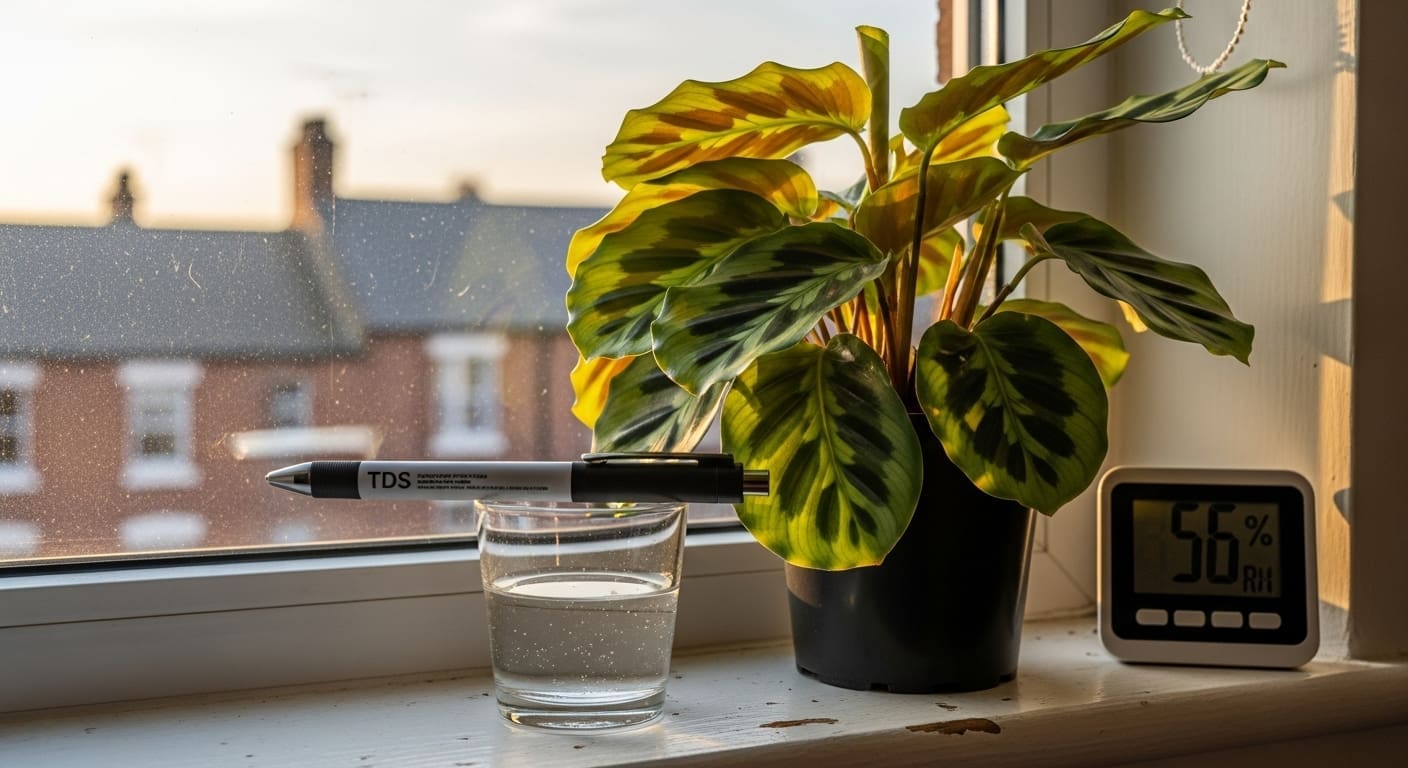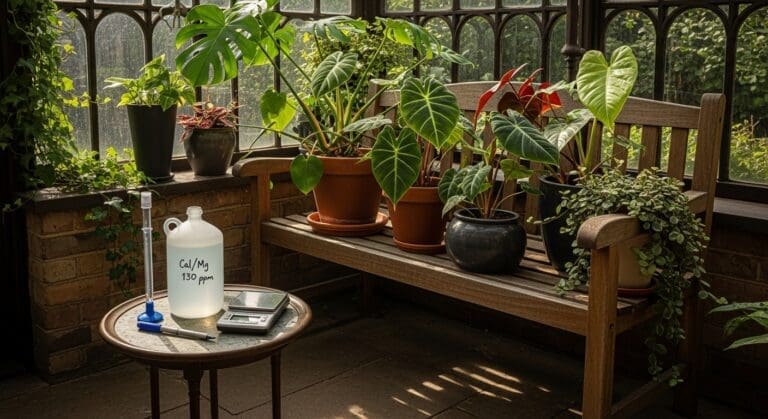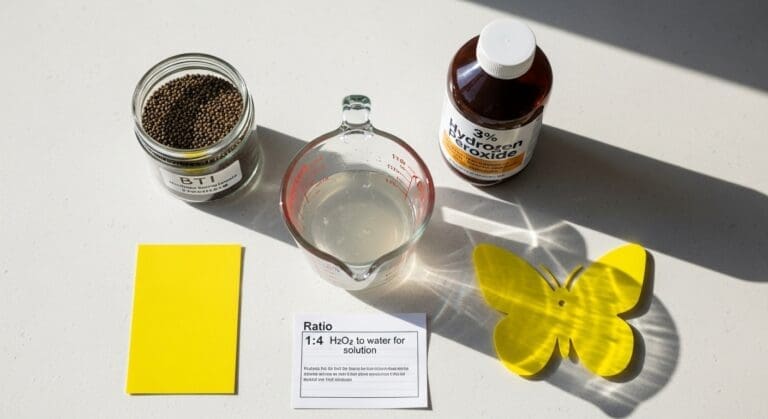Counterintuitive fact: Cracked Orbifolia leaves aren’t always a “humidity problem.” In soft-water homes, low calcium/magnesium can make new growth fragile—so it tears under normal handling. Get humidity and minerals right together, and the next leaf usually tells the story.
“I used to mist constantly. When I finally checked TDS and added a tiny Ca/Mg buffer, the cracking stopped—without turning my living room into a sauna.”
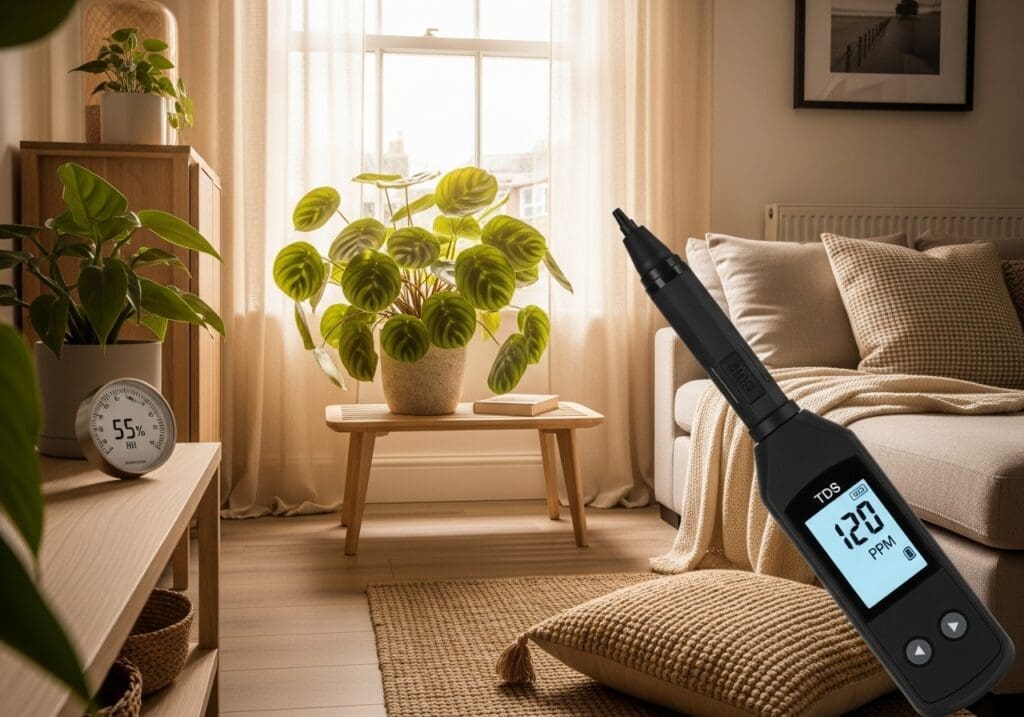
Quick answer (so you can act today)
- Leaf-level RH: aim 50–65% in living spaces; 65–75% during active unfurling if you can localize it to the plant.
- Water quality: avoid sodium-softened water; target TDS ~80–180 ppm (with ~20–40 ppm Ca and ~5–15 ppm Mg equivalent).
- If your tap is very soft (<60 ppm TDS): use rain/RO + a tiny Ca/Mg supplement to reach the band above.
- If your tap is hard (>250 ppm TDS): dilute 1:1 with RO/rain to land near 120–180 ppm.
- Handling: support unfurling leaves; drafts + sudden temp dips make thin tissue snap.
A practical humidity playbook for flats/homes (micro-zone kurma) için: Cloud Forest Plant Care & Humidity at Home.
Case study: “humidifier full, leaves still crack”
Small city flat, winter. RH hovers 42–48%, tap water 35–50 ppm TDS (very soft). Orbifolia pushes a new leaf every 5–6 weeks—edges are thin, and the lamina cracks along veins while opening.
Change 1: Swapped to RO + 30 ppm Ca / 10 ppm Mg (TDS ≈ 110–130 ppm) using a tiny Ca/Mg supplement.
Change 2: Local micro-zone to 60–65% RH using short humidifier bursts and constant, gentle airflow (fan aimed past leaves).
Outcome (2 leaves later): No cracking; thicker texture; same room averaged 50–55% RH.
“Once I stopped chasing 75% RH for the whole room and focused on minerals + a small micro-zone, the plant relaxed—and so did I.”
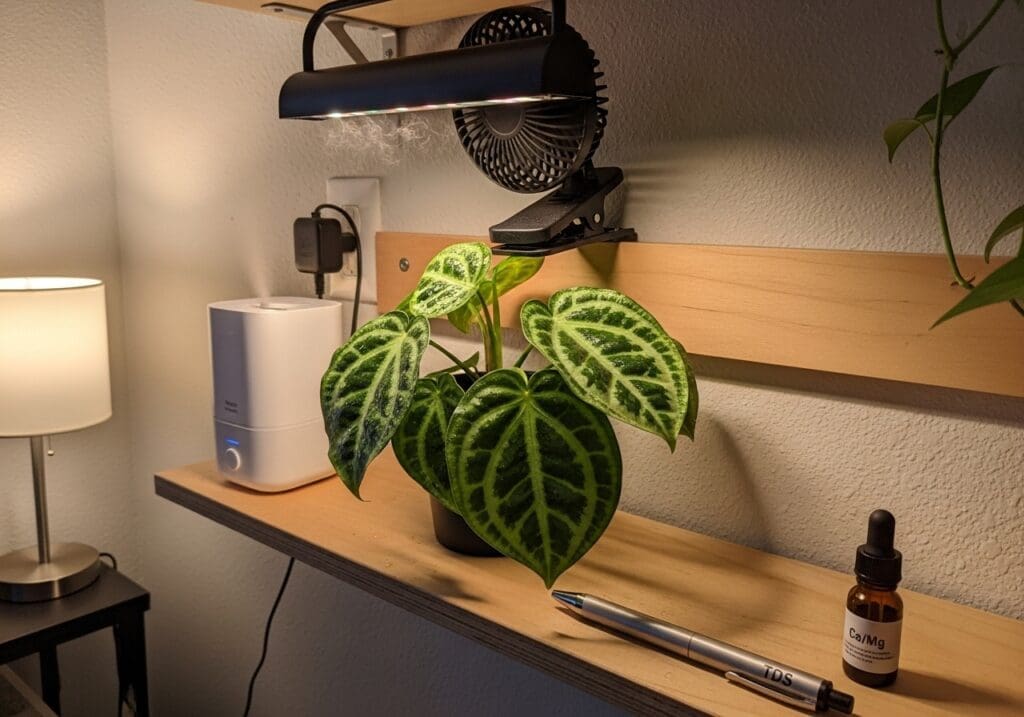
Background: why humidity and calcium both matter
- Humidity cushions unfurling tissue so it doesn’t crease or tear under small mechanical stress.
- Calcium is a structural element (cell walls/lamella). Deficiency shows in the newest growth: thin, weak, or misshapen leaves that damage easily.
- Soft water (low TDS) can be calcium-poor; sodium-softened water is a double hit (low Ca/Mg, higher Na). The RHS notes that domestic softeners exchange calcium/magnesium for sodium, making softened water unsuitable for many plants; rainwater is preferred.
For “bright-indirect” ışığı sayılara dökmek istersen, ev içi örnek hedefler burada: Best Light Conditions for Rare Tropical Orchids Indoors. (Lux ve yerleşim mantığı epifitler/ornamentaller için de işe yarar.)
ARTEFACT — TDS & action chart
| TDS (ppm) | What it hints | Likely risk | Action |
|---|---|---|---|
| <60 | Very soft | Low Ca/Mg → fragile new leaves | Add Ca/Mg to ~100–150 ppm; keep RH 55–65% while unfurling |
| 80–180 | Sweet spot | Balanced salts | Maintain; short RH boosts only during unfurling |
| 200–250 | Moderately hard | Salt stress on edges | Dilute 1:1 with RO/rain; target 120–180 ppm |
| >250 | Hard | Edges crisp; buildup | Prefer rain/RO; occasional leach (flush) |
Method note: A TDS pen reads total dissolved solids, not Ca/Mg specifically—but it’s a useful proxy for tap profiles and mixing ratios. Re-measure after any changes.
Decision matrix — which knob to turn?
- Cracks along veins on brand-new leaf (while unfurling): Raise RH to 60–70% locally for 10–14 days and push water to ~120–150 ppm TDS with Ca/Mg.
- Edges crisp on older leaves: Likely mineral buildup or hot/dry air. Leach pot (3× water volume), reduce TDS to 120–180 ppm, keep RH 45–60% with airflow.
- Accordion/new leaf deforms: Transient drought or calcium deficit. Stabilize watering rhythm; ensure some Ca/Mg in water and leaf-level RH 55–65%.
- Brown spots after misting: Surface wet + still air. Use humidifier bursts + airflow, not heavy mist on leaves. For “how to” micro-zone fikri: Cloud Forest Plant Care & Humidity at Home.
Targets that work at home
- Light: bright-indirect; 2–4 kLux at leaf in winter, 4–6 kLux in summer (sheer curtain if needed).
- Humidity: daily baseline 50–60%; 65–70% for unfurling week, then back down with airflow.
- Watering rhythm: keep mix evenly moist (never sopping).
- Water quality: land 80–180 ppm TDS; if mixing RO + tap, start 1:1 and re-test (often ~100–150 ppm).
- Leaching: every 6–8 weeks, pour 2–3× pot volume to prevent accumulation (especially if your tap >180 ppm).
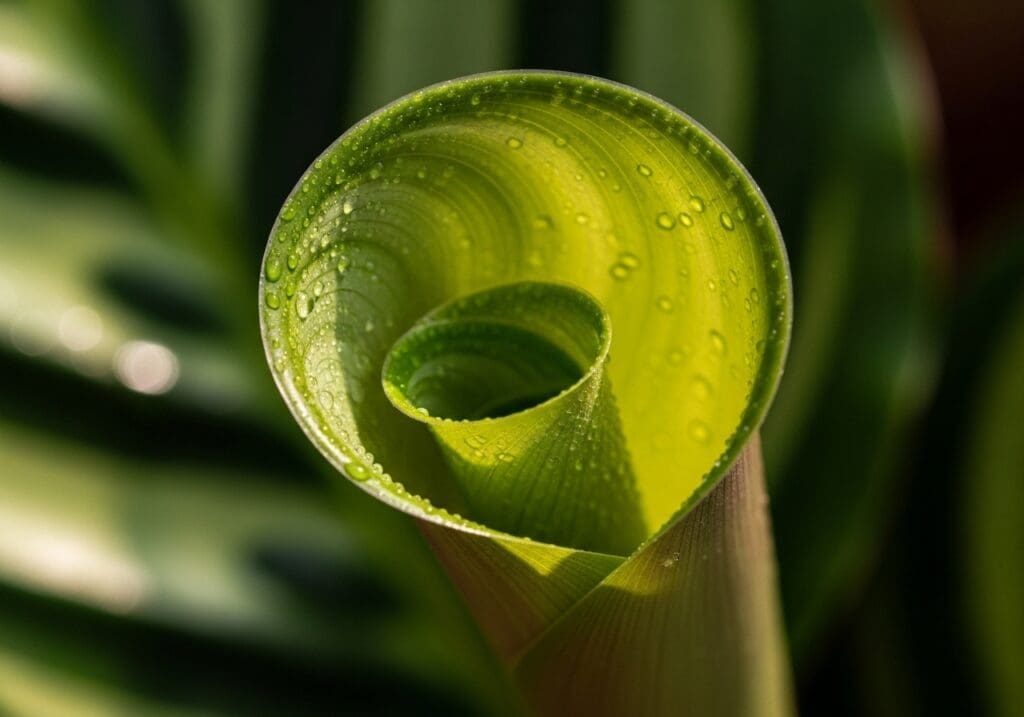
Common mistakes (and simple fixes)
- Only chasing humidity: Add minerals if water is very soft; aim TDS 100–150 ppm during growth.
- Using sodium-softened water: Switch to rain/RO or pre-filter; RHS recommends avoiding softened water for plants.
- Static air + wet leaves: Prefer humidifier bursts + airflow over heavy misting.
- Room-wide 70% RH: Build a local zone near the plant; keep living spaces comfortable.
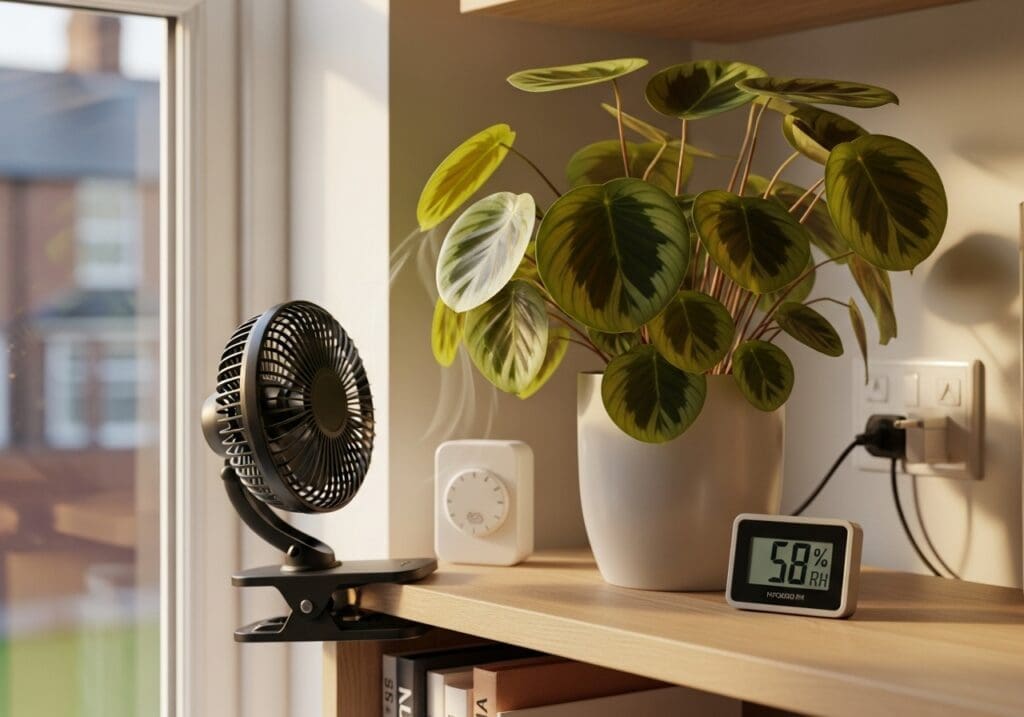
What I actually do in my apartment
I mix RO : tap 1:1 (lands ~120–140 ppm TDS), then keep a local 60–65% RH during unfurling with short humidifier pulses and a clip-fan skimming past the leaves. Every 6–8 weeks I leach the pot (2–3×) and let RH cruise 50–55% day-to-day.
Expert insight
The Royal Horticultural Society advises that softened water swaps calcium/magnesium for sodium, which is unsuitable for watering; rainwater is preferred for houseplants—calatheas included. That aligns with our approach: avoid sodium-softened water and provide some Ca/Mg in very soft-water homes. Read more: RHS — Water: using softened and other types.
FAQs
Is leaf cracking always a humidity issue?
No. Low Ca/Mg from very soft water makes new tissue flimsy. Pair 60–65% RH during unfurling with TDS ~100–150 ppm (with some Ca/Mg) and reassess on the next leaf.
Can I just use rainwater forever?
Yes, but if your plant shows fragile new growth, add a tiny Ca/Mg buffer to reach ~120–150 ppm TDS. Avoid sodium-softened water. RHS guidance backs this preference for rainwater over softened mains.
Should I change the potting mix?
Fragility is usually water quality + humidity. If mix is dense or stays wet, repot to an airy, peat-free blend and stabilize light/humidity using our numbers-based approach here: Anthurium Clarinervium — by numbers.
You don’t need a rainforest—just balanced water and a small, steady micro-zone. Hit the TDS band, keep RH kind during unfurling, and let your Orbifolia prove it on the next leaf.

RarePlantCare Editorial Team produces expert content on rare plants.
Our articles are AI-assisted and human-edited before publication.
We aim to provide practical, evidence-based guides for plant lovers worldwide.
Learn more about our Editorial Policy


